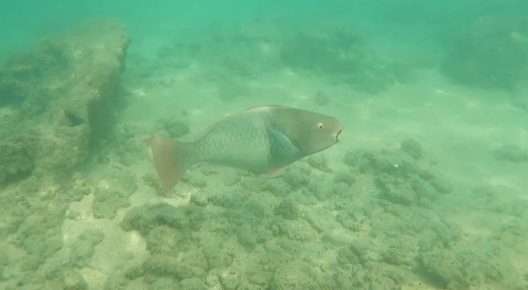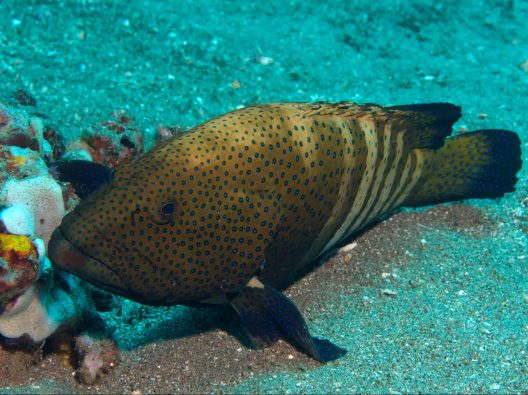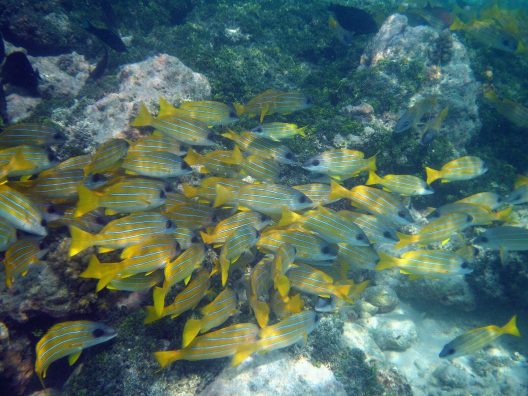A Journey to Hawaii’s Underwater Realm with Local Fish
As January’s cold winter winds sweep through Seattle, I invite you to read on for a virtual escape to Hawaii’s vibrant underwater realm. In this exploration, imagine the deep, rich blue waters, where the lively frolic of tropical fish dances beneath the shimmering surface. So, relinquish the chill of winter for a moment and wrap yourself in the comfort of words.
Growing up in Hawaii, I often found myself immersed beneath the sun-kissed waves of Hawaii’s Pacific ocean, surrounded by the rhythmic cadence of crashing waves. My childhood was uniquely shaped by the playgrounds that stretched beyond the sandy shores. While some of my peers were transfixed by television screens, my weekends were devoted to a different spectacle – beneath the surface of the Pacific. Snorkeling became a calming hobby, a gateway to a world where time slowed, and the vibrant coral reefs revealed their colors. One stroke after another, I glided through the coral reefs, in awe of the beauty and diversity of Hawaii’s underwater residents, each a testament to the delicate harmony of nature. Over the years, I developed a deep appreciation and admiration for the marvels of the ocean, propelling me towards a pursuit of knowledge in marine biology and marine and environmental affairs. Now, my commitment lies in contributing to the conservation of marine life.
The marine ecosystems that shaped my childhood adventures now serve as a microcosm within a larger ecological narrative, encompassing not only the vibrant coral reefs but also vast expanses of seagrass beds and rocky shores. Together, these habitats contribute to the unparalleled biodiversity of Hawaii’s underwater realm, featuring over 400 species of inshore and reef fishes. In this virtual escape, we journey through the Pacific waters, encountering native and invasive tropical fish that call Hawaii’s waters home. From iconic native fish like the humuhumunukunukuapua’a (Rhinecanthus rectangulus) and parrotfish (Scaridae), to the invasive species such as roi (Cephalopholis argus) and ta’ape (Lutjanus kasmira), each fish carries with them a story of adaptation, coexistence, and a delicate dance between the original inhabitants and those introduced to Hawaii’s waters.

The humuhumunukunukuapua’a, a tongue twister from my childhood, stands as a living testament to the captivating diversity of marine life in Hawaii. Only reaching up to ten inches in length, this fish is distinguished by their vibrant palette of colors – vivid yellow and black stripes with a blue mouth. Humuhumu means triggerfish and nukunukuapua’a means snouts like a pig. When this fish feels threatened, they make a grunting noise similar to a pig.
The humuhumunukunukuapua’a, holds a significant place in local mythology, particularly in their connection to the hog god, Kama Pua’a. Kama Pua’a fell in love with the goddess of fire and lava, Pele. Their relationship soon ended due to Kama Pua’a’s hoglike habits and Pele’s fiery temperament. As Pele sought to rid herself of Kama Pua’a, she unleashed lava and steam upon him, but he resisted. Pele then called for the help of underwater gods and Kama Pua’a was forced to retreat into the ocean. Kama Pua’a then turned into a humuhumunukunukuapua’a. This mythological narrative adds to the cultural significance of this triggerfish, which was designated as Hawaii’s state fish in 1984 and is a symbol of the state’s rich underwater heritage.
Roaming the coral reefs with an air of confidence, the humuhumunukunukuapua’a showcases their territorial nature, underscoring their resilience in the dynamic underwater landscape. As a fish in the Balistidae family, humuhumunukunukuapua’a are notoriously aggressive, hence their solitude and territorialism. They have the ability to alter their color hues, fading to dull colors when sleeping or demonstrating submission against stronger individuals and exhibiting vivid coloration when healthy and unthreatened. Additionally, with plump blue lips that create a cartoon-like appearance, this iconic fish is not merely a fish of the sea but a living work of art that captures the hearts of those who encounter their grace.

The uhu, or otherwise known as the parrotfish, plays a crucial role in keeping Hawaii’s coral reef ecosystem in balance. There are over a dozen different species including the bullethead parrotfish (Chlorurus sordidus), palenose parrotfish (Scarus psittacus), spectacled parrotfish (Chlorurus perspicillatus), and more. Additionally, uhu undergoes gender fluid color changes. These fish start their lives as females, which are more reddish-brown in color, and after reaching sexual maturity, the largest female will undergo a sex change, becoming more blue in color. Despite their sex, uhu are known for their vibrant neon colors, which makes them easy to spot. After spotting one, I often remain floating to hear the crunch-crunch-crunch noise of the parrotfish grazing on the coral. You would be surprised how well you can hear their teeth in their beak-like mouth scraping and crushing the hard coral skeletons.
Uhu are herbivores that scrape and eat the turf algae off corals, allowing corals to increase their surface area for more polyps. Moreover, uhu break down dead coral, and their waste creates sand, providing additional space on beaches for humans and creating additional habitats for marine invertebrates. Uhu is a favorite fish, so many fisherpeople target the larger males, disrupting the spawning balance, as uhu live in harems. As a result, females will prematurely change sex to males, and the harems become less productive at spawning. Just like us, uhu sleep at night, making them vulnerable targets for predators such as moray eels and spearfishers.

The roi, or otherwise known as the peacock grouper, holds the distinction of being the grouper with the widest natural distribution of over 150 species in the Serranidae family. Introduced from French Polynesia to Hawaiian waters in 1956 by the Division of Aquatic Resources, it was believed that the introduction of high-value food sources would bolster declining fish stocks in Hawaii. However, roi faced challenges in gaining popularity among Hawaiians due to concerns about a higher incidence of ciguatera, a toxin that can accumulate in some fish and cause illness in humans. Despite this, the peacock grouper is recognized for their vibrant body outlined with blue-green markings, dots, and stripes, reminiscent of the stunning plumage of a peacock, from which they derive their common name. Presently, roi stands as the most dominant inshore predator in the Hawaiian Islands.
The ta’ape, or otherwise known as the bluestripe snapper, swiftly moves around Hawaii’s crystal-clear waters with their captivating appearance, characterized by their sleek, yellow body and distinctive blue stripes. Growing up, I affectionately nicknamed the ta’ape “electric” due to their vibrant presence from miles away. I always admired the dynamic and lively energy this fish seemed to emit.
Originating from the Indo-Pacific, ta’ape found their way into Hawaiian waters with an unintended tale of ecological complexity. Despite their enchanting aesthetic, the ta’ape has garnered attention for their status as an invasive species in Hawaii. This fish was originally brought over from French Polynesia and introduced by the Division of Aquatic Resources in 1955 to boost local fisheries. Over time this introduction produced unintended consequences. Ta’ape is not a popular fish for human consumption, leading to low market value and as a result not often being fished. A commercial fishery was attempted but it quickly proved unprofitable.

The ta’ape has become well-established and competes with native fish for food and habitat. Their adaptability and prolific breeding habits, with fertilized eggs floating out to sea and dispersed by currents, have allowed the population to flourish, raising concerns about potential impacts on the ecological balance of coral reef ecosystems. This fish, once a personal fascination, now reflects broader environmental challenges around addressing concerns and complexities thoroughly before attempting to alter natural habitats.
As we emerge from our tranquil virtual escape and face the reality beyond the waves, let these underwater stories linger in our minds. While the enchanting marine life of Hawaii’s coral reefs may have captivated us, it is crucial to acknowledge the threats these fishes face. Unregulated fishing practices, particularly the targeting of larger uhu, jeopardize the delicate balance of coral reef ecosystems, emphasizing the need for stricter regulations. In response to these challenges, fisheries management initiatives are being implemented, integrating measures such as size limits and seasonal restrictions. It is imperative that we adhere to these regulations with respect. Furthermore, efforts are underway to advance the Holomua: Marine 30×30 initiative, aiming to effectively manage Hawaii’s nearshore waters with at least 30% established as marine managed areas by 2030. Despite the existence of numerous marine management areas in Hawaii, many remain small and permit various forms of human use. Only 3.4% of Hawaii’s nearshore is fully protected, with a mere 0.5% strictly prohibiting fishing. The opportunity to expand this protected space is crucial to providing complete protection, allowing fishes to grow, reproduce, and replenish fished populations.
Additionally, further research is essential to develop innovative strategies for controlling invasive species such as the roi and ta’ape, which pose ecological challenges. The absence of natural predators or parasites specific to these fishes means that, currently, fishing pressure stands as the sole safe and viable control method. Many local organizations are actively collaborating to educate the public about these challenges, fostering a harmonious coexistence within the social-ecological system and safeguarding the long-term health and sustainability of Hawaii’s marine ecosystems.